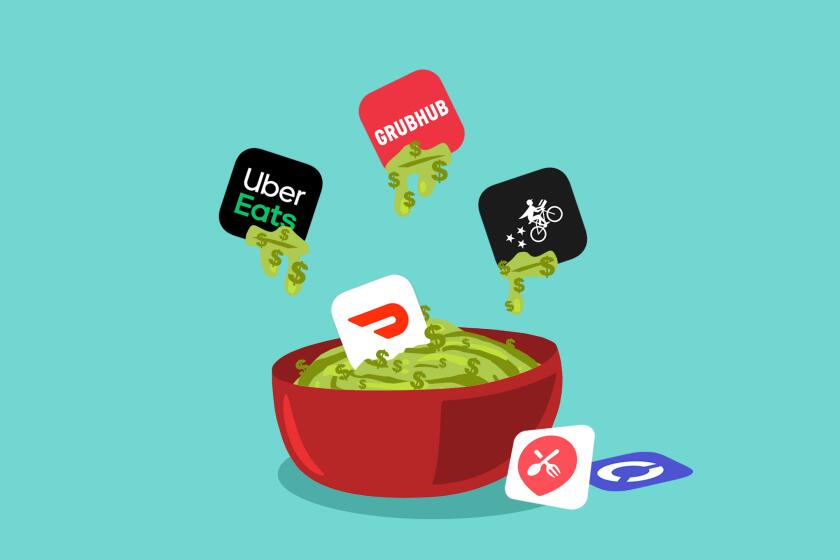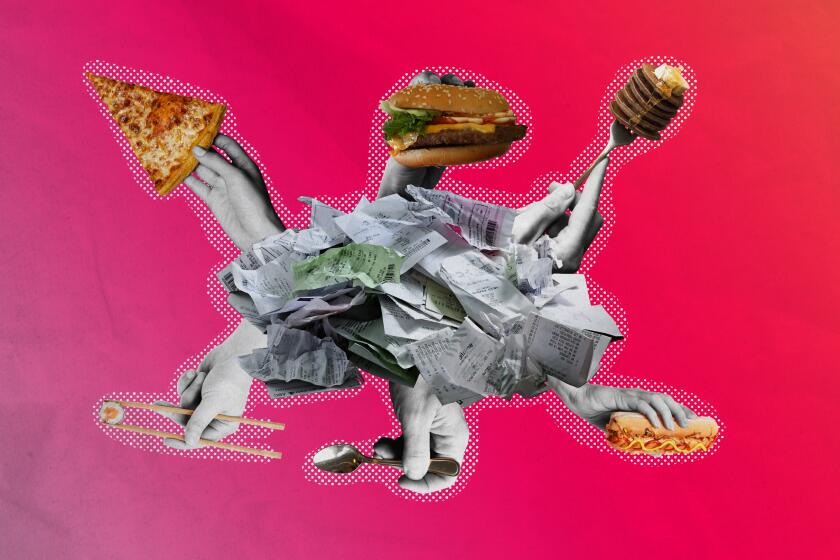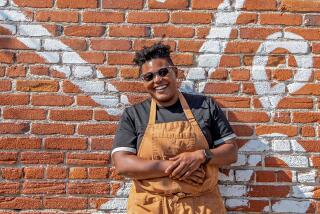New voices are vying for space in the food-delivery world

- Share via
Nabeel Alamgir keeps waiting for a cease-and-desist letter. If he gets one, he says he’ll view it as a badge of honor.
In January, the food-tech entrepreneur launched NotGrubhub.org, a map-based website that points customers to restaurants that take food orders directly. It was designed to bypass Grubhub and third-party food delivery apps and platforms that can legally charge up to 20% in commissions or marketing fees from restaurants in Los Angeles.
Any restaurant can add itself to the database, which is free to owners and customers and lists more than 120 businesses nationwide. “That’s just an awareness campaign,” says Alamgir, who used to work in food service. His is one of a number of emerging voices calling for lower fees and more accessible technology in the food delivery world.
The former chief marketing officer of Bareburger said he watched as his chain’s profits diminished over the years and realized if a national chain was hurting from app commissions and fees, mom-and-pop restaurants could be too.
In 2019 Alamgir cofounded Lunchbox, a platform that charges restaurants a monthly flat fee — as opposed to sales commissions — that range from $88 to $490, depending on the service package; most clients, he says, pay $200. The platform hosts and designs apps, websites and ordering pages; maintains the virtual end of cloud kitchens; and creates marketing materials like Instagram ads. Lunchbox also hires the same delivery drivers used by the big third-party platforms at the same cost of roughly $6 per driver per order and makes marketing technology and materials easier for restaurateurs and chefs to use.
(Hospitality group SBE and its virtual food-hall subsidiary, C3, used Lunchbox for an in-house app and website that allows customers to order from across the company’s 40-or-so delivery-only restaurants. “You can have an Umami [Burger], you can have a Krispy Rice, you can have a Sam’s Crispy Chicken,” says C3 CEO Sam Nazarian. “You can order from up to 15 menus at one time.”)
“A very messy system was created because restaurant people are not starting these tech companies — tech people are,” Alamgir says. “Restaurateurs are not tech people; they want to be hospitable and create amazing food and then we told them, ‘You’ve got to be amazing with tech as well or you’re dead. Your business is dead.’”
How third-party food delivery services are still crippling restaurants.
The new contenders tend to promise restaurants one of two things to remain competitive with larger, more established platforms: flat-rate fees, like Lunchbox, or commission rates that can hover as low as 2% as well as included marketing capabilities to help restaurants stay visible.
Grassroots and more locally focused newcomers can also offer hypertailored curation, privacy and a shift from third-party delivery systems entirely.
The owners of Pasadena-based DïNG — not to be confused with Ding Menu, a new commission-free restaurant ordering tool — say they want it to become the Spotify of food platforms by tailoring meal recommendations based off a two-minute quiz.
Former chef and DïNG cofounder Mike Chen said his background in data science helped inform the company’s algorithm, which is based on answers to questions such as, “What looks good for a cold winter night?” (Your options might be fish fillet in chile sauce; braised pork belly; or a soup of salted pork with bamboo shoots.)
The Asian-cuisine-focused operation also allows menu ordering, but the format is arranged by dishes or even region, as opposed to separate restaurants, creating a sort of editors’ pick of noodles, poached chicken, curries, stews and more from a mix of restaurants largely located in the San Gabriel Valley.
The platform charges a commission of less than 5%, and the startup also focuses on user privacy: Hired drivers, also used by third-party apps, pick up food from the restaurants and deliver them to designated DïNG handoff points. From there, the company’s own drivers deliver on the last leg of the route to avoid providing home addresses to the major platforms.
DïNG, spurred by the pandemic and still in its nascency, serves a limited radius with daily service. By the end of 2021, Chen hopes it will offer the same daily service to all of Los Angeles County as well as Ventura and Orange counties.
Spoon by H restaurant is closing after months of reduced business, chargebacks and refund requests during the pandemic. It’s just one of many restaurants footing the bill as diners discover new ways to dine and dash.
Some innovators never intended to enter the delivery business at all. Jared Jue envisioned MAMA as a restaurant-recommendation site, but as the pandemic began to shutter independent restaurants, the founder felt a need to preserve businesses in need — many of which are underrepresented in media and run by immigrant families.
With the help of Alice Han, MAMA launched Drive-By Kitchen, a new service that picks up an ever-changing lineup of dishes from multiple restaurants throughout L.A. and Orange County and then delivers them to three pickup locations: the Westside, Koreatown and Alhambra. The service is not offered on a daily basis; rather, it is scheduled approximately every other week. Customers must order in advance, almost like an event, and “tickets” are limited.
Drive-By Kitchen participants are frequently restaurants that can’t afford to join the major delivery apps or aren’t tech savvy, and they keep 100% of the profits. MAMA’s only charge to customers? A credit card service charge, along with a small fee for team members and gasoline.
“Businesses were kind of living and dying by the phone waiting for some sort of Doordash or Grubhub or Uber to come through, and I think it was mentally just draining because they weren’t getting what they needed,” Jue says. “We knew what we wanted to do was focus on placing large orders with the restaurants so that they could have something concrete, in a way.”
The format ensures restaurants don’t lose money on food costs, while the “combo-meal” format gives diners a new lineup every time. This year Drive-By Kitchen, which Han oversees, also launched a meal-matching program, where every meal sold gets matched by a charitable partner — doubling the restaurants’ revenues and donating that second portion to those in need, such as seniors in Chinatown.
“In terms of the big players in the market, we’re not trying to compete with them by any means; I think that they’re business-first, and our mission is more culturally relevant-first,” says Jue. “We’re really trying to preserve the dishes, the recipes, the restaurants — those kinds of things that will actually disappear at the end of this whole thing. Is it sustainable? I hope so. I hope we can change the conversation.”
More to Read
Eat your way across L.A.
Get our weekly Tasting Notes newsletter for reviews, news and more.
You may occasionally receive promotional content from the Los Angeles Times.













